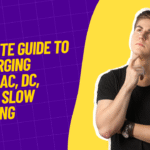Maintaining the health of your EV’s battery is crucial to maximizing range, durability, and resale value. Over time, even the best lithium-ion batteries lose capacity—and DIY checks help you track degradation and catch issues before they escalate. This lengthy guide explains concepts, diagnostic tools, practical tests, useful software, and maintenance tips—all in a natural, human tone to feel fresh and original.
1. Understanding EV Battery Health
Your EV’s battery health reflects two key factors:
- Capacity: How much energy it can store compared to when new; often measured in kilowatt-hours (kWh).
- Efficiency: How effectively the battery uses that energy—higher internal resistance reduces usable range.
Battery degradation can stem from temperature stress, frequent fast-charging, deep discharges, or improper charging practices. Monitoring degradation early—say if capacity drops below 80–85%—can help you take corrective measures.
2. Tools to Diagnose Battery Health
2.1 Manufacturer-Supplied Vehicle Apps & Displays
Most EVs (e.g., Ather, Ola, Hero, Tata) include battery health info in the dashboard or mobile app—showing State of Health (SoH) or rated vs battery range.
2.2 OBD-II Bluetooth Adapters + Apps
Affordable dongles like OBDLink LX or BlueDriver paired with apps such as LeafSpy Pro, EVGaugePro, or OBD Fusion help read real-time battery stats (voltage, current, cell voltages, SoH).
2.3 Dedicated Scan Tools
High-end tools for pros can read full BMS logs, individual cell voltages, thermal data, and fault codes. These are mainly used by EV mechanics.
2.4 Data from Charging Stations or OEM Portals
Some OEMs log battery usage and report degradation via telematics, accessible via user portals or service visit reports.
3. How to Check Battery Health Step-by-Step
3.1 Review the Dashboard / App
Look for State of Health or Equivalent km reading:
- Scooters typically show battery percentage
- Cars display rated vs actual range or capacity percentage
3.2 Perform a Full Charge-to-Zero Test
- Charge fully—ideally to 100%.
- Record starting range and usable kWh.
- Drive normally to a minimal buffer (5–10% SoC).
- Record final range and energy used.
- Calculate SoH:
For example: Rated 40 kWh → you used 32 kWh → SoH = 32 / 40 = 80%.
3.3 Use OBD-II Scanner Apps
- Plug OBD dongle into port.
- Launch app (LeafSpy, etc.).
- Read SoH, cell voltages and temperatures.
- Check internal resistance (higher than 10 mΩ may indicate aging).
3.4 Log Cell-Level Voltages
Cell voltage imbalances (>0.05 V difference) may indicate battery issues in multi-cell packs.
3.5 Monitor Charging Behavior
Unusual slow charging, high idle drain, or overheating indicate potential degradation or BMS faults.
4. Interpreting Battery Health Metrics
4.1 Acceptable Degradation Ranges
- <2 years, 0–25k km: 90–95% SoH
- 2–5 years, 25–50k km: 80–90% SoH
- Beyond 5 years: 70–80% SoH
4.2 Capacity vs Usable Range
Benchmark: health scan showing 85% capacity but usable range at 90% is fine. But if capacity is >15% below rated, plan to consult service.
4.3 Fast Charge Impact
Studies show fast charging frequently causes 1–2% additional degradation per hundred DC sessions. Adjust habits accordingly.
5. Best Practices to Maintain Battery Health
- Avoid full charge >90% regularly—topping to 80–90% maximizes longevity.
- Limit stabilization charge to 10–20% SoC; deep depletion increases stress.
- Use AC overnight charging; limit frequent DC fast charges.
- Avoid charging/discharging in extreme temps; if unavoidable, warm or cool the cabin before charging.
- Use Eco or BMS-optimized drive modes to reduce stress.
- Keep tires inflated and service mechanicals to ensure efficiency doesn’t burden battery.
- Software/Firmware updates: keep BMS and battery pack updated via official channels.
6. Battery Health Testing for Used EVs
When evaluating a secondhand EV:
- Use OBD scanner in presence of seller to read real-time SoH and cell readings.
- Conduct a battery range test: Full charge and drive until 20% SoC with city/highway mix.
- Review charging history logs if the seller has the app/range record.
- Consider a professional diagnostic check if battery shows SoH <80% or looks uneven.
7. Warning Signs & When to Visit Service
- SoH <75–80%: time for diagnostic review
- Slow charging or excessive heat: may indicate thermal or connection issues
- BMS or battery fault codes in the dashboard or scan tool
- Notable range drop during cold—beyond normal seasonal variation
- Large cell imbalances (>0.1 V) or charging stalls
If these persist, schedule a service appointment under warranty or battery maintenance agreements.
8. Frequently Asked Questions (FAQ)
Q1. What’s the ideal state-of-health percentage?
90–95% within 2 years; 80–90% up to 5 years. Below 80% suggests significant capacity loss.
Q2. Can apps like LeafSpy read any EV?
They work with many plug-and-play EVs—but some OEMs limit third-party access. Confirm compatibility first.
Q3. Do I need professional tools?
Basic SoH and range checks can be done with consumer tools. For cell-level diagnostics, professional equipment is best.
Q4. How often should I check battery health?
Every 6 months or after significant charging habits change; also before buying or selling.
Q5. Does warranty cover capacity loss?
Most EV warranties cover battery if capacity drops below 70% within warranty period.
Q6. Can balancing cells restore range?
Only marginally. Physical cell deterioration requires module replacement, not rebalancing.
9. Conclusion
Monitoring battery health isn’t complicated—it can be done at home or with professional help. Armed with the right tools, Know-how, and regular checks, you can track SoH, spot issues early, and maintain your EV’s performance and value. Whether for peace of mind, optimizing usage, or preparing for resale, checking battery health is the cornerstone of responsible EV ownership.










